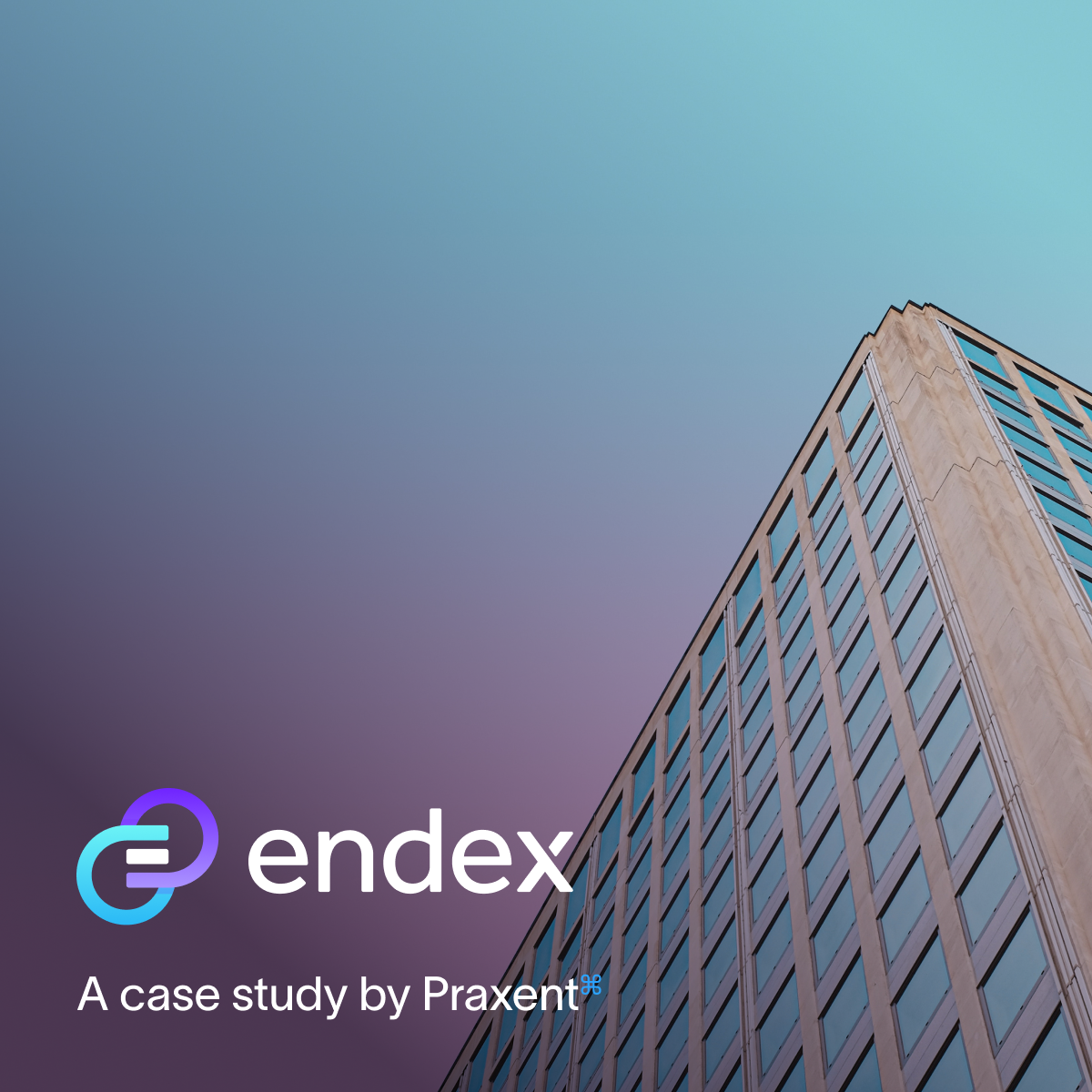
8 min read
Endex by Praxent

A fintech startup sees an immediate return on investment in a clickable prototype that enables cofounders to visualize a more user-focused design for their application, raise funding, and move seamlessly into development—much faster than anticipated.
Summary
Founded in early 2021 by Brittany Wright and Kevin Loo, Endex is a social investment platform that gives users access to thousands of high-performing, peer-managed, themed portfolios they can copy for free. Users can also connect with and build a community of like-minded retail investors, enabling them to invest alongside their friends, family, coworkers, and others with help from some of the top influencers in the investment community.
After focusing the first five months on developing their idea, envisioning their product, raising awareness, and partnering with accelerators, the cofounders reached a decision point: Should they raise money, start marketing, or start developing?
They knew they eventually wanted to seek friends and family and venture capital (VC) funding, and in order to do that, they would need to help potential investors visualize their app. Previously, they had used iPhone mockups—they made two screenshots of the main screens for the app using PowerPoint, but they needed something that could help them better convey their vision so people could get an idea of what using the app would actually be like. Creating a prototype, they realized, would help them move forward with fundraising, marketing, and development simultaneously.
An advisor introduced them to Praxent, and they were immediately impressed by the design team’s deep understanding of their application and their goals. They decided to move forward with designing and developing a clickable prototype, which along with an app map, wireframes, and style guide, they were able to complete in just four weeks, enabling them to hit an important milestone, secure additional funding, and move into development much faster than they had originally anticipated. Development has been seamless thanks to the frontend design work, and they are on track to launch in early 2022.
The problem
Early-stage ventures, especially when they are only made up of co-founders or a founding team, often become echo chambers of ideas. In many ways, the Endex co-founders didn’t know what they didn’t know—they needed an outside perspective. Then there’s the chicken-versus-egg struggle: You need investors in order to raise money to develop your product but in order to attract the investors, you need a way to take them beyond the idea to an actual product, which you don’t yet have. The co-founders needed a way to get to the next stage—they had an idea but no funding, demo, functional app, or developers.
Not being technical co-founders, they couldn’t develop the app themselves. They considered offshoring the development of a functional demo or prototype with actual features they could use to build their application, but that would take the time they didn’t have. They needed a prototype that would help them demonstrate their app visually as well as interactively—not just paving the way for more funding but also enabling their marketing efforts and setting up a more seamless development process.
How we helped
Praxent’s expert design team worked closely with the founding team, diving deep into their goals for the app and helping them to apply design thinking from the earliest stage. This led to conversations around the brand, including design and colors, but also the user, which led to new feature ideas that informed the creation of the prototype.
From a project management standpoint, the founders appreciated the streamlined process and that they only were required to attend 1-2 hours per week of meetings, freeing them to focus on other important aspects of growing their venture while the Praxent design team took care of everything else.
Praxent’s approach included:
Design Thinking Workshop as an initial kick-off facilitated session that enabled the designers to:
- Gather and align stakeholder opinions and ideas
- Align around common goals, target audience, outputs, expectations, and product requirements
- Capture information that guided the creation of the design prototype
App Map that defined the UX architecture and flow of the app for primary users, including novice and expert investors
Key Wireframes that illustrated three to five key features/user tasks using easily adjustable low-fidelity designs
High-Fidelity Clickable Prototype to allow the client, investors, and developers to experience the key workflows as they would look on the finished app.
Design Style Guides to accelerate frontend development in parallel with testing.
Results
Early feedback from internal advisors, friends and family, and prospective users who had only heard about or seen mockups of the app but can now “see” and “experience” it, has been overwhelmingly positive, which is extremely encouraging for the founders. They were accepted into an accelerator and were able to secure additional funding, which helped them to move into development.
Developers have been able to use Praxent’s design files to guide their coding and build out the application on the backend. The team could quickly make edits and see how they’re going to look before they actually put them into the code. This has enabled development to stay on track, and the founders are thrilled by the prospect of launching their application sometime in early 2022.
The prototype also has enabled them to build out their marketing efforts. Their social media pages and followings are growing, they’ve started to pursue influencer collaborations and partnerships, and they are building brand awareness. They are looking to start a new round of fundraising in order to secure angel investors as they seek institutional and VC funding in the new year. Finally, they are talking to larger brokerages in hopes of securing more integrations.
“I think we’re at a really good stage; things are moving fast. … It’s nice that my cofounder and I have time to focus on other aspects of the business as we get more people involved on the team and helping us build out our product.”
Key Features
Create an Endex and link your brokerage: In this first step, users can create their own account, create an Endex (recommended stock portfolio), and also link it to their existing brokerage to start investing.
In this step, users are able to create and customize an Endex (stock portfolio or essentially a “playlist of stocks”) and link their existing brokerage to invest directly in the Endex app.
The platform enables users to customize their index privacy, stocks, weighting methodology, and rebalancing frequency.
Connecting with Friends and Content Creators: Users can create and join group chats and communities based on their interests.
They can also join an Endex’s specific chat to get a better understanding of decisions being made by other investors and the Endex creator.
Copying Top Portfolios: Users can easily discover Endexers created by other Endexers and that align with their needs, interests, and values, via the explore page, leaderboard, or by searching specific tags. After reviewing individual stock components, performance history, and an Endex’s characteristics, users can copy (invest in) an endex with the click of a button. Users can find and research stock options, explore trends, and discover portfolios that align with their needs and interests and also copy an entire portfolio from Endexers.
Endexers is a term coined by the founders to describe users dedicated to creating and publicly sharing custom indexes or Endexers for other users to follow or copy. are the content creators for this platform whose profiles are open for users to copy them totally or partially.
Key Deliverables
Creation of the App Map to align and prioritize features based on the Customer Journey Map.
Categorization of features based on the investor’s appeal and interests as High-Priority, Potential, and Future
Design of specific user workflows for each of the high-priority features with targeted delivery by the end of the project.
UI Style Guide: Praxent created a detailed style guide to ensure the UI felt unified and consistent moving forward.
Wireframes to focus on the user experience. The style guide was applied to them to create unified UI designs.
High-Fidelity Prototype that brought the client’s startup idea to life and enabled them to impress investors and secure funding.


Leave a Reply